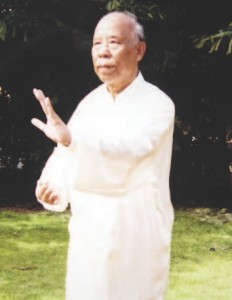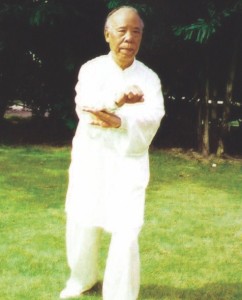A conversation with Master Wu Wenhan
By Dave Barrett, Translated by Yang Jun
 Dave Barrett: In America many people are unfamiliar with the Wu/Hao style of Taijiquan. I wanted to begin by asking you to describe the differences between Yang style and Wu/Hao style Taijiquan.
Dave Barrett: In America many people are unfamiliar with the Wu/Hao style of Taijiquan. I wanted to begin by asking you to describe the differences between Yang style and Wu/Hao style Taijiquan.
Wu Wenhan: Let me answer your question in two parts. First let me tell our why our style is called Wu/Hao. In the middle of the Qing dynasty in Hebei Province, Yongnian County, Guangfu town had two famous Taiji masters; one was Yang Luchan (1799-1873), and the other Wu Yuxiang (1813-1880). Let me tell you how Wu Yuxiang created his style. Master Wu’s family was in service to the government and Wu Yuxiang had placed highly in the Imperial examination. In the Wu family, the men were highly placed civil servants, almost like generals. At that time Yang Luchan returned from his studies with Chen Changxin. So Yang Luchan’s job was teaching Taijiquan in his hometown and he and Wu Yuxiang became good friends. At this time there was no special term for Taijiquan. The Chen style was referred to as Long Fist, in Yongnian County the termwas Cotton Fist or Sticking Fist. So after Master Wu Yuxiang learned from the Yang family, he went back to Wenxian County, Zhaobao town and found a master named Chen Qingping (1795-1868). During that time Wu Yuxiang’s brother, Wu Changxin found a book in a salt shop by Wang Zongyue called the Taiji Classics. So he gave this book to Wu Yuxiang and he brought it back to his hometown. From this point both Yang Luchan and Wu Yuxiang began to follow the theories in this book, also they brought their local culture and martial styles together. Actually, they also combined what they had learned from Chen Changxin and Chen Qinping, they combined many things together with the theory of Wang Zongyue to create a new martial art we now call Taijiquan. Later on Yang Luchan went to Beijing and began teaching and from this point Taijiquan began to spread out.
For the second part of my answer I’d like to talk about the differences between the Yang and Wu/Hao styles. Masters Yang Luchan and Wu Yuxiang were very good friends, studied and practiced together, sharing their knowledge. Using Wang Zongyue’s theories, they created Taijiquan. Using what they learned in Chenjiagou and Zhaobao, combined with local Yongnian techniques, guided by Wang Zongyue’s theories they began to change these styles by taking out the jumping and stamping techniques, hard and fast movements. They replaced these with an emphasis of softness.
DB: Was it at this time that the motions became much slower?
WW: Yes. This was a gradual process, it didn’t happen overnight. At the beginning both Yang and Wu styles had some jumping movements but they had already taken out the stamping techniques.
DB: Why did they take these type of motions out?
WW: They were influenced by Wang Zongyue’s concepts, which formed a new base and foundation for the motions. Of course they learned from the Chen style but at that time Wang Zongyue’s book was unknown to the Chen masters. This is an important point: martial arts need a theoretical base for the practice to develop. Secondly how do you show it? Perform it? Both the Yang and Wu styles developed here in Yongnian County started by using the Chen form, “Lazy about Tying the Coat” which evolved into our Grasping the Bird’s Tail and finished with Bend the Bow Shoot the Tiger, so they are similar in structure from start to finish. The old Chen style started from Warrior Pounds the Pestle and it was a different sequence. Later Wu Jianquan (1870-1942) and Sun Lutang (1861-1932) developed their styles from a Yang family foundation so their forms sequences are somewhat similar.
The third point I’d like to make concerns Push Hands. In the Chen style, when they used this in the old days it was a very basic technique: just moving back and forth. Bringing this basic exercise back to Guangfu town, Yang Luchan began to develop more detailed techniques. The Yang family made it’s living from teaching martial arts, they had a very rich experience and effective training methods. The Wu/ Hao style also developed more complex Push Hands patterns. They contributed a good deal to the development of Push Hands and weapons training. We should say that Wu Yuxiang and Yang Luchan founded Taijiquan.
DB: These two gentlemen were close friends, they lived in the same town, did they work together to create the form sequences we have today?
WW: Yes. They worked together and used many of the same form names and although the two styles are different they share many similarities.
DB: The reason I ask is that many students might think Taijiquan came just from Yang Luchan and we should recognize and celebrate the contributions of the Wu family to Taijiquan’s development.
WW: The reason perhaps why the contributions of the Wu family are not so well known is that the Yang family were professional martial arts teachers. The Wu family was not dependent on teaching for their livelihood. The relationship between the families was quite close. Because of this friendship actually when Yang Luchan went to Beijing to teach he was introduced by Wu Yuxiang’s brother.
DB: Was that how Yang Luchan gained entry into the Forbidden City?
 WW: Actually Wu Yuxiang’s brother worked in the legal system and introduced him to the Imperial Guards as a martial arts teacher; without this family friendship there would have been no such introduction.
WW: Actually Wu Yuxiang’s brother worked in the legal system and introduced him to the Imperial Guards as a martial arts teacher; without this family friendship there would have been no such introduction.
DB: This is a very important part of the history of Taijiquan’s development.
WW: Let me tell you about why our style is called Wu/Hao Taijiquan. The Wu family was quite rich and part of the local aristocracy. They didn’t teach Taijiquan for a living. They were well educated and came from a long line of military men. Because of this background Wu Yuxiang loved to research martial arts. Later on during the Taiping Rebellion (1850-1864) many towns had to organize protective forces against the rebels. Wu Yuxiang led this organizing effort in Guangfu town.
DB: During the Taiping Rebellion did the Wu family train the townspeople of Guangfu using these new techniques?
WW: According to historical records we have no clear picture as to whether this training was done. One of Wu Yuxiang’s nephews was in the military and trained his soldiers. The Qing government gave Wu Yuxiang a special title for his service during the Taiping Rebellion.
So this was Wu Yuxiang’s special character, he loved to research martial arts and he was a leading figure in Yongnian. Later on he had three disciples. The first was Li Yiyu (1832-1892), his oldest nephew, the second was also his nephew Li Qishen, they were brothers and also Yang Banhou (1837-1892), Yang Luchan’s second son. Because Yang Luchan was in Beijing, his family remained in Guangfu town. Yang Banhou was tutored by Wu Yuxiang who also taught him Taijiquan. This is why the Yang family historically had two styles one called the large frame and the other small frame. When Yang Banhou was twenty he went to Beijing and he also was a military instructor who rose to the sixth rank out of seven.
Wu Yuxiang remained in Guangfu town and continued to research and develop Taijiquan Theory. Taiji’s theory comes from three sources; first is Wang Zongyue, second is Wu Yuxiang and the third is Li Yiyu. Li Yiyu was not a professional martial arts person but he had a disciple: Hao Weizhen (1849-1920). Hao He was his styled name. He spread Wu style to the public.
DB: Was he the same generation as Yang Chengfu, teaching at the same time?
WW: Yes they were the same generation but Hao Weizhen was a bit older than Yang Chengfu. So this is why our style is called Wu/Hao because Hao Weizhen was the one who taught publicly also we needed a way to distinguish this in English from the other Wu style developed by Wu Jianquan. The first Wu style Taijiquan manual was written by Hao Weizhen’s grandson, Hao Shaoru. The difference between the Yang and Wu families is that the Yang Family taught from generation to generation and the family developed this art. Wu Yuxiang’s style or the Wu/Hao style was not passed through this family process, because they did not teach for a living. Actually, the Wu style developed by Hao Weizhen passed through three generations. The second generation teacher was Hao Yueru (1877-1935), he first taught in Yongian and later he went to Shanghai. The third generation master, Hao Shaoru (1907-1983) also went to Shanghai. So this Wu style was spread by the Hao family. This is my answer to your first question. The reason Taijiquan is so popular and successful comes from the collaboration between Wu Yuxiang and Yang Luchan. Since Yang Luchan, the Yang style has developed practical training methods which work quite well. The Wu/Hao contribution has been to develop the theories of Taijiquan. The latter generations of these two families also worked together to combine practice and theory and improve the level of training.
Here in Yongnian County, Taijiquan developed not just by continuing Chen style techniques. They learned from the Chen system but they redesigned and created new forms. This is of particular interest to me and I spend my time researching the development of Taijiquan. How do we distinguish between different martial arts? First we examine theory. Secondly, the performance of the forms is considered. Thirdly, what are the teaching methods? These three points help us evaluate the differences. For example, many sports use balls: basketball, baseball, and ping pong, what are the differences? The rules are different, the games are different and the training is different This is what I mean, there are so many types of Chinese martial arts but how do we say one is Bagua and the other is Shaolin? Because of these three points. From my point of view Taijiquan was not simply originated in Chenjiagou. After these two gentlemen came back from studying Chen style they created a new martial art called Taijiquan and Guangfu town was its birthplace. Of course there is a relationship with the Chen style but it was not just a simple transition. Later on, when Chen Fake was teaching in Beijing in the 1950’s, there were debates as to whether his style was really Taijiquan because the three criteria were so different. What was missing from the Chen style were any of the 13 kinetic energies and theories from Wang Zongyue. DB: I just have one more question: in your research, Wu Laoshi, what have you learned about Wang Zongyue? Where was he from? Do we know anything about his background and training?
WW: The question cannot be answered clearly. We know only a few basic facts. He was from Shanxi Province. He lived during the Qianlong era of the Qing Dynasty (1736-1796). His theories were based on local Shanxi martial arts. What we have today is only his theory, nothing about the actual performance of his techniques. Yang Luchan and Wu Yuxiang used these theories, combined with what they had learned from the Chen family to create Taijiquan. They continued to develop this new style using Wang Zongyue’s theories.
DB: Thank you so much for your time and insight into the history of Taijiquan! ☯
Reprinted from Journal 25, 10th Anniversary Issue, Summer 2009
